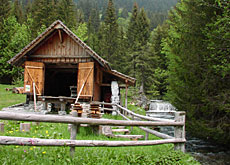Old mills keep turning for the tourists

Switzerland has preserved its pre-industrial heritage by restoring dozens of old watermills.
Many of the mills, like the Schwarzwaldalp sawmill between Grindelwald and Meiringen, have been resurrected as tourist attractions.
The Schwarzwaldalp sawmill was erected in 1896 in order to provide the planks, boards and beams for the construction of a grand hotel.
It was the Belle Époque and tourists were flocking to the region to get a closer look at the majestic mountains of the Bernese Oberland.
The tourists were mainly British and after a stop in Meiringen, were taken by horse-drawn carriage up a narrow road past waterfalls and a gorge to the alpine meadow known as Schwarzwaldalp.
Grand hotel
The grand hotel allowed them to wine and dine in luxury at the foot of towering peaks.
But two world wars and a depression put an end to tourism and the hotel burnt down in the 1940s.
Ironically, the sawmill outlived the hotel by about 30 years, continuing to provide the building materials for the area’s small alpine farming community.
By the 1990s, though, the mill was close to collapse. Its wheels, shafts, pulleys and saws hadn’t turned, spun and cut for over 20 years.
Restoration
We knew there were only two options, we either had to tear it down, or try to restore it,” remembers Guido Schilling, president of the Schwarzwaldalp Sawmill Foundation.
That was in 1996, the mill’s centenary.
Schilling – a sports psychologist who has a weekend home next to the mill – turned his talents to fundraising in order to convince public officials and private citizens that the mill was an integral part of the region’s heritage.
Forgotten skills
The foundation was able to raise SFr300,000 ($233,000) and was fortunate to find volunteers with the nearly forgotten skills needed to get it operating again.
“I did my apprenticeship in a sawmill very much like this one from 1951 to 54,” recalls retired carpenter, Werner Sulzer.
Sulzer is one of three volunteers who have been operating the mill since the restoration was completed three years ago. He and his colleagues fill orders from local farmers and give guided tours.
His tour begins a couple hundred metres behind the modest wooden structure.
Waterwheel
This is where water from the Pfanni Stream is channelled through a refitted pipe and a raised wooden canal in order to gain sufficient speed to turn the large waterwheel.
By pulling on a lever which activates a metal trapdoor, Sulzer can control the amount of water dropping onto the wheel, to increase or decrease the number of rotations per minute and thus the speed of the saw.
The ground floor of the mill resembles the inner workings of a medieval wooden clock.
The waterwheel first cranks a spur wheel fitted with wooden teeth, which in turn activates a steel transmission wheel, whose job it is to put a further series of wooden wheels attached by pulleys into motion.
The sole function of all the wheels is to operate a singular straight saw on the floor above.
The saw can cut one log at a time, which is mounted onto a bed or “runner”.
A cogwheel pulls the runner and log automatically toward the saw, allowing the sawmill worker to attend other business, which today amounts to explaining the whole process to visitors.
“The mill is a living witness to a pre-industrial technology,” says Schilling. “I find it amazing that they were able to build it in a place that at the time was so remote and inaccessible.”
swissinfo, Dale Bechtel in Schwarzwaldalp
The Schwarzwaldalp Sawmill is open from 9.30am to 6pm on Sundays in June, Wednesday to Sunday in July and August and Friday to Sunday in September.
Schwarzwaldalp is reachable via a narrow road either by private car or bus from Meiringen in the direction of the Grosse Scheidegg Pass.
Meals and accommodation can be had in the “Chalet-Hotel Schwarzwaldalp” next to the mill or further down the road towards Meiringen in the 19th century Hotel Rosenlaui.
There are countless well-marked hiking trails in the area, and many visitors come to see the Rosenlaui Gorge, which is accessible via a footpath (entrance charge).

In compliance with the JTI standards
More: SWI swissinfo.ch certified by the Journalism Trust Initiative

You can find an overview of ongoing debates with our journalists here. Please join us!
If you want to start a conversation about a topic raised in this article or want to report factual errors, email us at english@swissinfo.ch.